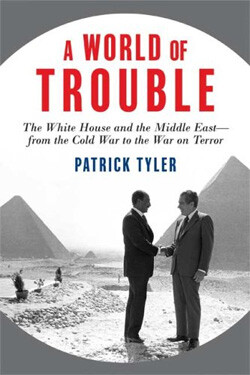The Electronic Intifada 13 April 2009

The coherence and continuity imputed to US policy in the region by analysts owes more to broad-brush theorizing than to a careful appraisal of the contingent realities that have shaped it. The structural determinism of these accounts overlooks the ad hoc nature of the policies and brushes over the discernible personal stamps of key individuals. Tyler’s indispensable corrective begins with Dwight D. Eisenhower, among whose priorities the Middle East never ranked high until the Suez crisis in 1956. Like Truman he resented Zionist influence on the US government, but whereas the former had opted for a politically expedient accommodation, Eisenhower refused to compromise. Both Eisenhower and his CIA Director Allan Dulles liked Egyptian President Gamal Abdel Nasser, who they saw as an anti-communist modernizer. They aided his consolidation of power. The Israeli government resented this and even resorted to terrorism at one point to wean away the US.
But where violence failed, influence proved decisive. The Israel lobby, along with the anti-China and cotton lobbies, blocked promised funding for the Aswan Dam, and the administration’s subsequent refusal to sell arms to Egypt led Nasser to turn to the Soviets for assistance. Nevertheless when Israel, Britain and France launched their invasion in 1956, Eisenhower considered intervening militarily to defend Egypt. He feared this unilateral act of aggression would render irrelevant the new UN-led world order which the US was promulgating. When his proposal to discipline Israel met with resistance in Congress he took the case directly to the American public, thereby neutralizing the lobby’s pressure.
There was a marked change in US policy with the ascension of Lyndon Johnson who ushered in a pronounced pro-Israel tilt. A convert to Zionism out of political expedience, Johnson was quick to revoke the restrictions Kennedy had been trying to impose on Israel’s nuclear program. Kennedy had kept Israel at a wary distance and opted for conciliation with Arabs. In contrast, writes Tyler, Johnson “had put himself in the service of Israel like no other previous president,” deferring judgment on key occasions to his coterie of informal Jewish advisers which included among others a former member of the Zionist terrorist group Irgun. Unlike Eisenhower, Johnson would accept Israel’s conquests during the 1967 war, ignoring the judgment of his own cabinet, and would thereby permanently undermine the UN charter.
It was not until Richard Nixon’s presidency however that the US emphatically committed itself to arming Israel. It was as much a cynical ploy on Nixon’s part to deflect pressure from the Watergate investigations as it was a result of his National Security Advisor and later Secretary of State Henry Kissinger’s machinations which on occasion bordered on the treasonous. Kissinger had advanced his career by undercutting a nascent peace plan by Secretary of State William Rogers who, like Nixon, worried that Israeli intransigence was undermining US oil security. During the 1973 war when Nixon and Defense Secretary James Schlesinger argued that the US should only be obliged to defend Israel, not its conquests, Kissinger dismissed the distinction as irrelevant “fine tuning” and went on to do things which, as Tyler euphemistically puts it, raise “constitutional questions.” First, Kissinger whose commitment to the Zionist cause formed “the bedrock of [his] view of the Middle East,” raised a false alarm that other Arab armies were about to join the war against Israel. He then fomented a confrontation with the Soviets in order to buy Israel more time; he contravened Nixon’s orders for engaging the Soviets in a joint ceasefire proposal; he travelled to Israel and encouraged the Israelis to resist Nixon’s pressure and breach the ceasefire in order to finish off Egypt’s encircled Third Army; finally, he lied to Nixon about Soviet intentions and about the extent of domestic pressure in order to secure arms shipments to Israel as a response to this “Russian treachery.”
Tyler concludes that Kissinger maneuvered “as if he were a partisan for Israel’s war aims” and “his actions throughout the crisis added up to a focused advocacy more for Israel’s strategic goals than for those of the United States.”
Tyler skips over the Ford administration which was uneventful except for the proposal to “reassess” the US relationship with Israel. Ford climbed down after receiving a letter drafted by the Israeli lobby group AIPAC to which 76 senators had signed their names. Jimmy Carter was likewise challenged by the lobby when he became the first US president to broach the idea of a Palestinian “homeland.” However, he proved a more formidable adversary. Though he occasionally ceded ground, through sheer tenacity he also managed to extract concessions from the Israelis. The conviction with which Carter threatened to cut funding in response to Israel’s 1978 invasion of Lebanon led Israeli Prime Minister Menachem Begin to exclaim “It’s over” before ordering a withdrawal. In stormy sessions with Begin, according to Moshe Dayan, Carter delivered his indictments which “could not have been expressed in a more hostile form.” (So “disgusted” was Carter with Begin’s tactics that he said he would have asked Begin to “get the hell out” had he not been a guest.) It was this same tenacity that would eventually allow him to force Israel to withdraw from the occupied Egyptian Sinai peninsula, despite Begin’s reluctance and the opposition of the lobby. Carter’s wish for a comprehensive Middle East peace would not come to fruition as a result of his failure to win re-election in 1980.
Ronald Reagan began his presidency on a firmly pro-Israel footing, but he found his attempts at strategic cooperation with Israel repeatedly frustrated by an intransigent Begin who he felt always ignored the US national interest.
This tension was exploited by Reagan’s secretary of state Alexander Haig who would frequently leverage Israeli power in his bureaucratic struggle against the president and the administration Realists (Vice President George H.W. Bush, Defence Secretary Caspar Weinberger, and National Security Advisor William Clark). Haig blocked Weinberger and Bush’s attempts to penalize Israel for its attack on Iraq’s Osirak reactor. He also gave the green light to Israeli Defense Minister Ariel Sharon for his plan to reshape the Middle East by invading Lebanon. Reagan ignored the Realists’ advice to sanction Israel and sided with the neoconservatives who argued that the invasion benefited the US by sending a message to the “Soviet-backed radical Arab front.” The Realists on the other hand maintained that “Israeli militarism with American arms … was hurting America’s image in the Middle East” making it harder “to build a strong anti-Soviet alliance.”
The US engagement in Lebanon ended in carnage with the retaliatory bombings of its embassy and Marines barracks in Beirut after its forces openly joined the conflict on the rightist Phalange’s side. To the neocons’ great consternation, Reagan decided to withdraw against their advice. The administration also became the site of contest for the two regional powers, Saudi Arabia and Israel, both vying for the status of “strategic asset,” which culminated in the bizarre Iran-Contra affair.
The relationship between the US and Israel reached its nadir under the George H.W. Bush administration, whose secretary of state James Baker riled many of its supporters by telling them bluntly to “lay aside, once and for all, the unrealistic vision of a greater Israel.” On another occasion, he threatened to expel the Israeli ambassador. In the wake of the 1991 Gulf War, Bush and Baker initiated a peace process in Madrid which would end prematurely with Bush’s loss to Bill Clinton in the 1992 election. Bush’s withholding of loan guarantees in order to force Israel to freeze settlement construction and his decision to appeal directly to the people in the face of lobby pressure would prove to be his epitaph. After claiming credit for a largely Norwegian effort at peacemaking in order to burnish his credentials as a statesman, Clinton did little to hold Israel to its promises. Indeed, he allowed himself to be pushed around by both Israeli prime ministers Benjamin Netanyahu and Ehud Barak (with the former at one point trying to involve Clinton in an assassination conspiracy against Palestinian resistance leaders). His advisers were former lobbyists for Israel who, according to one member of his negotiating team, all too often served as “Israel’s lawyers.” He only returned to the issue with some conviction in the waning days of his administration, and when Palestinian leader Yasser Arafat refused the unreasonable Israeli offer that he was trying to impose on him, he would join the Israelis in blaming Arafat. Worse, he made a point to poison the Palestinian well with the incoming George W. Bush administration by blaming all on Arafat, who he called a “goddamn liar.” Before leaving office, Clinton also allowed himself to be what Tyler calls “duped and bribed” by people who were “closely connected to the Israeli intelligence agency Mossad” to grant a pardon to the fugitive financier and Mossad asset Mark Rich (Barak intervened personally with Clinton on Richs’s behalf).
While much of the book benefits from extensive primary-source research including declassified documents obtained through the Freedom of Information Act, there is a discernible decline in quality in the chapter dealing with the George W. Bush presidency. The only interesting new information that Tyler provides, based on eyewitness testimonies, are in the prologue. These include CIA Director George Tenet’s drunken tirade, while swimming in Saudi prince Bandar bin-Sultan’s pool, against the “assholes” in the Pentagon and the “crazies” in the Vice President’s office. “[T]he Jews,” he complained, referring to the administration neoconservatives, were scapegoating him for the war. In another scene we have Bush personally authorizing the torture of detainees by ordering the CIA to “Stick something up their ass!” The rest is a rather unremarkable account of the events leading up to war.
Despite its occasional flaws (mostly to do with Middle East history, which is not the book’s focus), A World of Trouble is the most important contribution to the debate over US foreign policy since professors John Mearsheimer and Stephen Walt and Jimmy Carter’s respective interventions. Painstaking research, intelligent analysis, incidental detail and a novelist’s eye for irony and narrative make it immensely readable despite its considerable length and grim subject matter. No student of US foreign policy or Middle East conflicts can afford to ignore the wealth of new information Tyler presents. The book is likely to prove an invaluable resource for those seeking to steer US policy in a less destructive direction. Unfortunately, many putative supporters of the Palestinian people have accepted the dubious proposition that Israel serves as a “strategic asset” for the US, or, as it were, its “aircraft carrier.” Tyler’s greatest contribution is to debunk this myth with copious evidence that proves this claim to be a minority view in the US establishment (propagated mostly by Likudniks such as Kissinger, Kirkpatrick and Haig). Indeed, policy makers have long seen the US Sixth Fleet as Israel’s “ultimate security guarantor.” Israel is a liability, and to continue to insist otherwise — whether it is out of the fear of the lobby’s reprisals, or to sustain materialist dogma — is to do the Palestinians a great disservice. Fortunately, as Tyler’s evidence if not his conclusions confirm, the political-strategic case for breaking with Israel is just as compelling as the moral one.
Muhammad Idrees Ahmad is the co-founder of Pulsemedia.org. He can be reached at m.idrees A T gmail D O T com
Related Links




